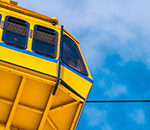Every landscape photographer has played the waiting game—when you forget about all personal comforts and safety in an attempt to capture the perfect photo with the perfect light. As you go out shooting more often and learn from your mistakes, certain necessities will become apparent, but they can be forgotten or overlooked in the beginning. Pye from SLR Lounge offers some great tips to capture stunning landscapes and avoid common mistakes while waiting for peak color:
Time of Day
When you shoot landscapes, you typically want to shoot at two times during the day—sunrise and sunset. Peak color—when the colors are the most beautiful—comes when the sun is just below the horizon.
Composition
It’s doesn’t matter if you’re shooting in automatic mode or manual mode; the first thing you need to do is set up your composition. Get your camera set up on the tripod and try a few test shots.
Dynamic Range
You’ll notice that as you increase ISO, you’re reducing the dynamic range of the image. So, say at ISO 400, the range of detail from shadows to highlights is low and there is less color and sharpness, but ISO 100 will preserve dynamic range.
Aperture and Shutter Speed
In landscape mode, the mountain setting on the dial, you can switch into ISO 100 and the camera will know to use an aperture that gives you a broad depth of field. If you want full control, you can switch to manual. Then you can set the ISO to 100, choose an aperture that gives you a broad depth of field, and if you’re shooting water, you can slow down the shutter speed to add a whispy effect to the water—down to 1/10 second, 1/5 second or even 1 second to really show the motion.
General Tips for Landscape Photography
- Shoot in RAW and JPEG. RAW will give you maximum dynamic range.
- Bring warm clothes. You might be waiting for peak color for a long time.
- For the same reason, bring extra batteries.
- Check the weather before you go out. If there’s cloud cover, it can hinder perfect light.
Pye starts out with his trusty Nikon D5200 equipped with a Tokina 11 – 16mm wide-angle lens. But, as the hours go on, the battery dies, so he switches to a Canon 5D Mark III. The Mark III still delivers great results, but the D5200 has a broader dynamic range so it would have given a better image.
He also forgot to bring warm clothes, so he was uncomfortably cold during the shoot. And finally, he didn’t anticipate cloud cover so he was unable to capture the perfect light. The final image still turned out great, but he could have saved himself a lot of trouble had he been more prepared. As I said, you learn from your mistakes!
Like This Article?
Don't Miss The Next One!
Join over 100,000 photographers of all experience levels who receive our free photography tips and articles to stay current:







Leave a Reply